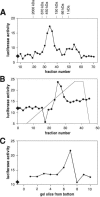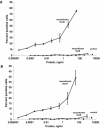A cysteine-rich extracellular protein containing a PA14 domain mediates quorum sensing in Dictyostelium discoideum
- PMID: 15947191
- PMCID: PMC1151990
- DOI: 10.1128/EC.4.6.991-998.2005
A cysteine-rich extracellular protein containing a PA14 domain mediates quorum sensing in Dictyostelium discoideum
Abstract
Much remains to be understood about quorum-sensing factors that allow cells to sense their local density. Dictyostelium discoideum is a simple eukaryote that grows as single-celled amoebae and switches to multicellular development when food becomes limited. As the growing cells reach a high density, they begin expressing discoidin genes. The cells secrete an unknown factor, and at high cell densities the concomitant high levels of the factor induce discoidin expression. We report here the enrichment of discoidin-inducing complex (DIC), an approximately 400-kDa protein complex that induces discoidin expression during growth and development. Two proteins in the DIC preparation, DicA1 and DicB, were identified by sequencing proteolytic digests. DicA1 and DicB were expressed in Escherichia coli and tested for their ability to induce discoidin during growth and development. Recombinant DicB was unable to induce discoidin expression, while recombinant DicA1 was able to induce discoidin expression. This suggests that DicA1 is an active component of DIC and indicates that posttranslational modification is dispensable for activity. DicA1 mRNA is expressed in vegetative and developing cells. The mature secreted form of DicA1 has a molecular mass of 80 kDa and has a 24-amino-acid cysteine-rich repeat that is similar to repeats in Dictyostelium proteins, such as the extracellular matrix protein ecmB/PstA, the prespore cell-inducing factor PSI, and the cyclic AMP phosphodiesterase inhibitor PDI. Together, the data suggest that DicA1 is a component of a secreted quorum-sensing signal regulating discoidin gene expression during Dictyostelium growth and development.
Figures




Similar articles
-
Discoidin I from Dictyostelium discoideum and Interactions with oligosaccharides: specificity, affinity, crystal structures, and comparison with discoidin II.J Mol Biol. 2010 Jul 16;400(3):540-54. doi: 10.1016/j.jmb.2010.05.042. Epub 2010 May 24. J Mol Biol. 2010. PMID: 20580724 Free PMC article.
-
Structure determination of Discoidin II from Dictyostelium discoideum and carbohydrate binding properties of the lectin domain.Proteins. 2008 Oct;73(1):43-52. doi: 10.1002/prot.22038. Proteins. 2008. PMID: 18384150
-
gdt1, a new signal transduction component for negative regulation of the growth-differentiation transition in Dictyostelium discoideum.Mol Biol Cell. 2000 May;11(5):1631-43. doi: 10.1091/mbc.11.5.1631. Mol Biol Cell. 2000. PMID: 10793140 Free PMC article.
-
Structural similarities and functional diversity of eukaryotic discoidin-like domains.Biochim Biophys Acta. 2007 Sep;1774(9):1069-78. doi: 10.1016/j.bbapap.2007.07.007. Epub 2007 Jul 24. Biochim Biophys Acta. 2007. PMID: 17702679 Review.
-
Expression of recombinant glycoproteins in the simple eukaryote Dictyostelium discoideum.Biotechnol Genet Eng Rev. 1997;14:1-35. doi: 10.1080/02648725.1997.10647937. Biotechnol Genet Eng Rev. 1997. PMID: 9188148 Review. No abstract available.
Cited by
-
DPF is a cell-density sensing factor, with cell-autonomous and non-autonomous functions during Dictyostelium growth and development.BMC Biol. 2019 Dec 2;17(1):97. doi: 10.1186/s12915-019-0714-9. BMC Biol. 2019. PMID: 31791330 Free PMC article.
-
Extracellular signaling in Dictyostelium.Int J Dev Biol. 2019;63(8-9-10):395-405. doi: 10.1387/ijdb.190259rg. Int J Dev Biol. 2019. PMID: 31840778 Free PMC article. Review.
-
Cell density sensing and size determination.Dev Growth Differ. 2011 May;53(4):482-94. doi: 10.1111/j.1440-169X.2010.01248.x. Epub 2011 Apr 27. Dev Growth Differ. 2011. PMID: 21521184 Free PMC article. Review.
-
Eco-evolutionary significance of "loners".PLoS Biol. 2020 Mar 19;18(3):e3000642. doi: 10.1371/journal.pbio.3000642. eCollection 2020 Mar. PLoS Biol. 2020. PMID: 32191693 Free PMC article.
-
A quorum-sensing factor in vegetative Dictyostelium discoideum cells revealed by quantitative migration analysis.PLoS One. 2011;6(11):e26901. doi: 10.1371/journal.pone.0026901. Epub 2011 Nov 3. PLoS One. 2011. PMID: 22073217 Free PMC article.
References
-
- Alexander, S., L. M. Sydow, D. Wessels, and D. R. Soll. 1992. Discoidin proteins of Dictyostelium are necessary for normal cytoskeletal organization and cellular morphology during aggregation. Differentiation 51:149-161. - PubMed
-
- Anjard, C., M. van Bemmelen, M. Veron, and C. D. Reymond. 1997. A new spore differentiation factor (SDF) secreted by Dictyostelium cells is phosphorylated by the cAMP dependent protein kinase. Differentiation 62:43-49. - PubMed
-
- Anjard, C., C. Zeng, W. F. Loomis, and W. Nellen. 1998. Signal transduction pathways leading to spore differentiation in Dictyostelium discoideum. Dev. Biol. 193:146-155. - PubMed
-
- Brazill, D. T., D. F. Lindsey, J. D. Bishop, and R. H. Gomer. 1998. Cell density sensing mediated by a G protein-coupled receptor activating phospholipase C. J. Biol. Chem. 273:8161-8168. - PubMed
-
- Brock, D. A., F. Buczynski, T. P. Spann, S. A. Wood, J. Cardelli, and R. H. Gomer. 1996. A Dictyostelium mutant with defective aggregate size determination. Development 122:2569-2578. - PubMed
Publication types
MeSH terms
Substances
LinkOut - more resources
Full Text Sources
Other Literature Sources
Molecular Biology Databases
Research Materials

